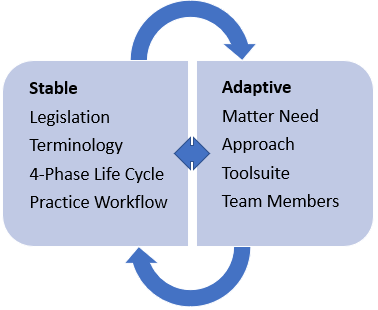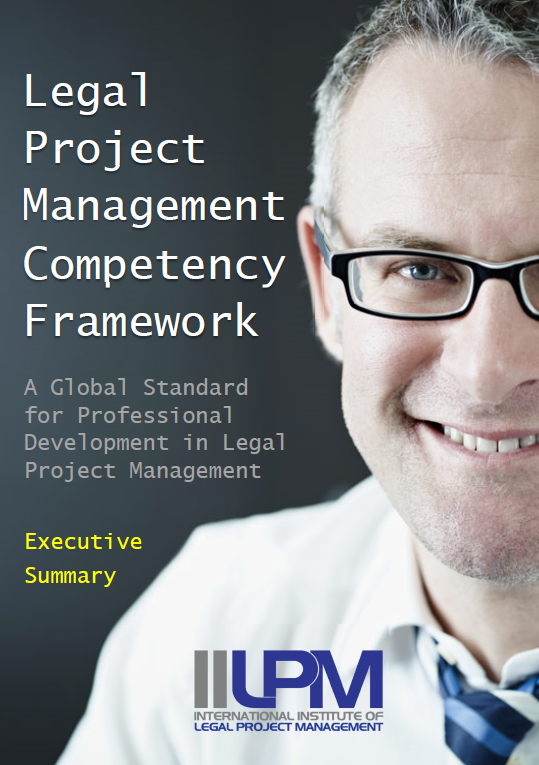A New Era of Focused Productivity
Legal Project Management (LPM) has become a worldwide trend for driving innovation, progressing alternate fee arrangement models, streamlining practice processes, and increasing the overall productivity of legal service providers. LPM is used particularly for the efficient planning and execution of legal matters, which vary in size, complexity and legal practice area.
Applying LPM practices within a legal environment has not been successful for all providers however. Challenges have been linked to the poor selection and application of tools and techniques, the inability to integrate those methods with existing systems and processes, and the lack of education and implementation knowledge. This has highlighted a need to better define a framework for how LPM is used and implemented.
The International Institute of Legal Project Management defines legal project management (LPM) as the “application of project management principles and practices to enhance the delivery of legal services”. A global study conducted by the International Institute of Legal Project Management[1] of lawyers in nine different countries found that when referring to LPM, it also covered the application of technology, process improvement, and leadership skills.
This means an LPM framework does need to cover the integration of appropriate project methods with the use of legal technology, workflow systems and processes, and their interaction with people. It needs to support legal work by offering streamlined technology-supported, efficient and repeatable processes.
As legal matters get more complex, there is a higher reliance on a wider team of people. Standardised processes become far more important when a lawyer needs to depend on a team over managing the legal matter just by their own focused efforts and enthusiasm. Complex legal matters call for team synergy, and knowing who is working on what, when tasks are planned to end, the dependencies between tasks, and the overall status of everyone’s work. This is all possible with applying legal project management principles and practices.
A History Change to Legal Practice
There are four key drivers behind LPM’s popularity within legal service providers, comprising the need for:
1. expanding client pricing options – the shift from the Billable Hour to other Alternate Fee Arrangements (AFA) that warrant more planning rigour and the ability to increase productivity to ensure profit is retained. When implementing models like fixed priced legal services, there is a greater need for speed whilst maintaining quality. Productivity is increased through analysis of the people, technology and processes, as the faster the work is completed, the more financial benefit it brings (that is opposite to the billable hour model that rewards the lawyer on the longer it takes). In-house council are also seeking new pricing options in managing their own legal spend;
2. integrating productivity elements – the focus on efficient and effective work practices that covers the integration of systems, processes and team performance to maximise productivity at each point. This requires the selection of appropriate software and devices, including new disruptors like artificial intelligence, that actually help the progress of legal matters and increasingly offer greater customisation and configurable workflow processes. This is best addressed by taking a legal design approach that looks at orchestrated human-centered design that maximises the user experience;
3. building mental resilience – the focus on the wellbeing of the legal team in having a greater sense of control that reduces stress levels in the workplace. In fact, having more control of the workflow also addresses the need for better mental wellness, as stress can be defined as a ‘real or perceived loss of control’. When a lawyer loses control their stress levels rise. As process guides behaviour, having a well-defined process, greater information access, and more insights to the where the performance of a legal matter is, brings a greater sense of more control. This is one of the reasons why traditional project management methods of risk management, issues management, variation (change) management, and performance tracking is so valuable to legal practice; and
4. developing high performing teams and service capabilities – the focus on guiding high performing behaviour that leads to greater knowledge and skills capabilities. This covers the need for stronger leadership and to build the soft skills competencies that leads to more effective communications, interactions and engagement with fellow colleagues and clients. It requires a lessons learnt review process at the end of a complex matter that feeds back into future improvements.
Change is Inevitable and Needed
The legal profession has been known to be slow to change. This can be argued simply on the fact that project management practices, fixed priced services and automation using technology are common and well utilised in other sectors.
As Altman Weil (2016)[2] noted, “Despite the fact that 93{f2f34f8ccf078d00edc9c87e107bf555a3545134b99da9962c07023f796f5c0f} of law firm leaders think a focus on improved practice efficiency is a permanent trend in the legal market, fewer than half of all law firms (44{f2f34f8ccf078d00edc9c87e107bf555a3545134b99da9962c07023f796f5c0f}) have significantly changed their strategic approach to efficiency – seemingly a large strategic disconnect”.
Whilst USA studies are now suggesting over 40{f2f34f8ccf078d00edc9c87e107bf555a3545134b99da9962c07023f796f5c0f} of larger US law firms are engaging in LPM trainings, they report only 33{f2f34f8ccf078d00edc9c87e107bf555a3545134b99da9962c07023f796f5c0f} of law firms are actively using LPM to support legal work (24{f2f34f8ccf078d00edc9c87e107bf555a3545134b99da9962c07023f796f5c0f} for in-house legal teams)[3]. This is likely due to the need to revamp both technology use, processes and the human factors that bring successful change. It could simply be that LPM and its components are not well known, and there has been a lack of formal frameworks and supporting tools that explain it.
Trying to avoid using technology, resisting new work practices and staying solely with the billable hour model is likely to force clients to go to other law firms that are evolving. When examining the changing legal market, Georgetown Law (2015)[4] noted, “… it is increasingly clear that the buying habits of business clients have shifted in a couple of significant ways that have adversely impacted the demand for law firm services”. They concluded that, “We now live in a buyers’ market in which all of the key decisions about how legal services are delivered and priced are being made or strongly influenced by clients”.
LPM implementation strategies actually do not promote simply jumping into the latest technology, it starts with changing the mindset of those involved and focusing on the workflow where technology is only part of the solution. This is why process improvement and selecting tools wisely makes for a better transformation into what will work for the legal service.
Standardisation Versus Adaptability of an LPM Framework
Process guides behaviour, and therefore standardisation can assist in accelerated team learning toward high performance and repeatable practices. Consistency helps shape brand and culture. Equally, being agile and flexible when it is called for, is also good business practice.
Standardisation starts with the fact that all legal matters follow the same four phase life cycle model of: Define, Plan, Deliver and Close. Legislation, terminology and the legal practice’s systems, processes and workflows offer a level of stability. The adaptive elements come from the fact that legal matters have different needs, uses different team members, often call for different tools and sometimes even require a variation to the approach. This provides a stable framework that supports flexibility to meet the specific legal matter needs.

In developing a workable LPM framework there are four key factors to consider:
1. Industry Factors – the need to first set the context to the legal environment from considering the external factors, such as the market forces, regulatory influences and the specific nature and commercial factors of a legal relationship;
2. Workflow Factors – the need to change the level of planning and execution effort in accordance with the unique needs of the legal matter;
3. Productivity Factors – that considers the tools and specific approaches required to support the legal matter’s progress; and the
4. People Factors that considers the leadership, communications and interactions with and between the key stakeholders that ultimately influences the culture and capabilities of the legal service entity.
Therefore the IILPM LPM Framework was designed to recognise the:
- external influencing factors of the legal market, regulatory and commercial factors;
- four phase life cycle stages of define, plan, deliver and close;
- key functions and elements under each phase;
- productivity tools and enabling approaches; and
- people and organisational capability elements.
Introducing the LPM Framework
The LPM Framework provides a methodology that guides legal service providers on how to structure a legal matter, and the key factors that support its success.
It promotes legal matters following a four-phase approach, comprising the:
1. Define phase that starts the client engagement;
2. Plan phase that only considers the depth and rigour level required for the effort involved, cost and risk factors (noting that some legal matters do not need a formal matter plan);
3. Deliver phase where the work is progressed and the oversight of performance, risks, issues and variations; and
4. Close phase where the legal matter comes to an end, including the need to review the performance and make recommendations to management for how-to better manage similar legal matters in the future, providing a process improvement focus.
The LPM Framework sets out the key processes in each phase, but recognises that legal service providers are best equipped where they have taken a legal design approach to defining their workflow processes and use of technology, including selecting tools such as checklists and templates. The LPM Framework is supported with a number of templates developed by the International Institute of Legal Project Management.
The LPM Framework aims to guide the required transformation changes within the legal practice or in-house counsel portfolios, and the need to improve legal service culture that is adaptive and embraces technology advances.
LPM is being embedded in teaching, technology, and practice management approaches that enables the modern legal practitioner to become more agile and adaptive to the progressive legal profession changes of tomorrow.
Special Bonus – watch the video:
About the Author: adjunct Associate Professor Todd Hutchison LPP
Adjunct Associate Professor Todd Hutchison is the Chairman of the International Institute of Legal Project Management, a former global Board Director of the Project Management Institute, and an awarded and practising international project manager.
He heads the global management consultancy and training company Peopleistic, including the Peopleistic Legal PM division. He also holds adjunct positions with CQ University, Edith Cowan University and Curtin University, resides as part of the MBA academic staff at the Australian Institute of Management, and is undertaking legal project management research in collaboration with universities such as Leeds Trinity University.
Todd has worked as an advisor, consultant, trainer and practice manager for law firms, and in-house counsel. He is an international bestselling business author, a certified professional speaker, has been recognised in the Top 101 Industry Experts specialising in project management, and is listed in the prestigious Who’s Who of Business in Australia.
Get Free Access to our Legal Project Management Tips eBook
Join our eNewsletter and get access to our fast track videos to understand what Legal project Management is.

